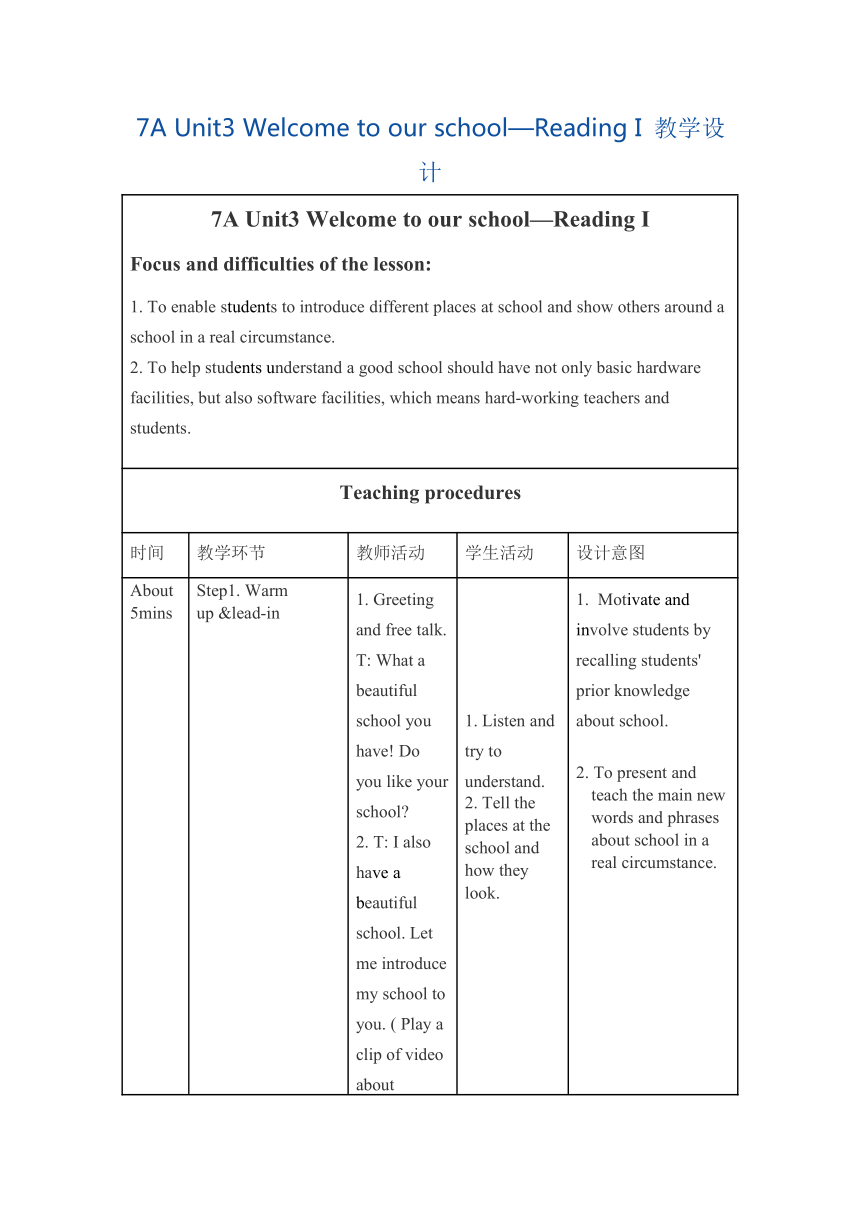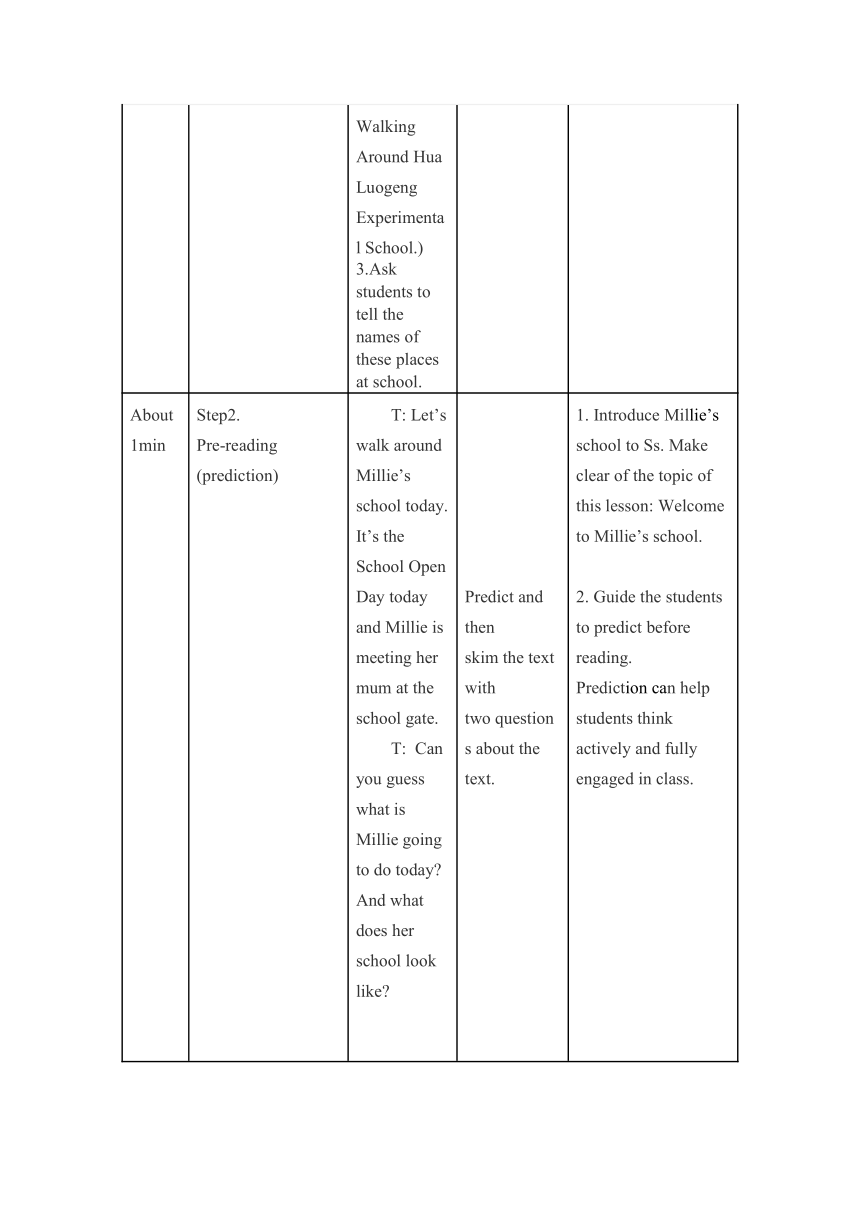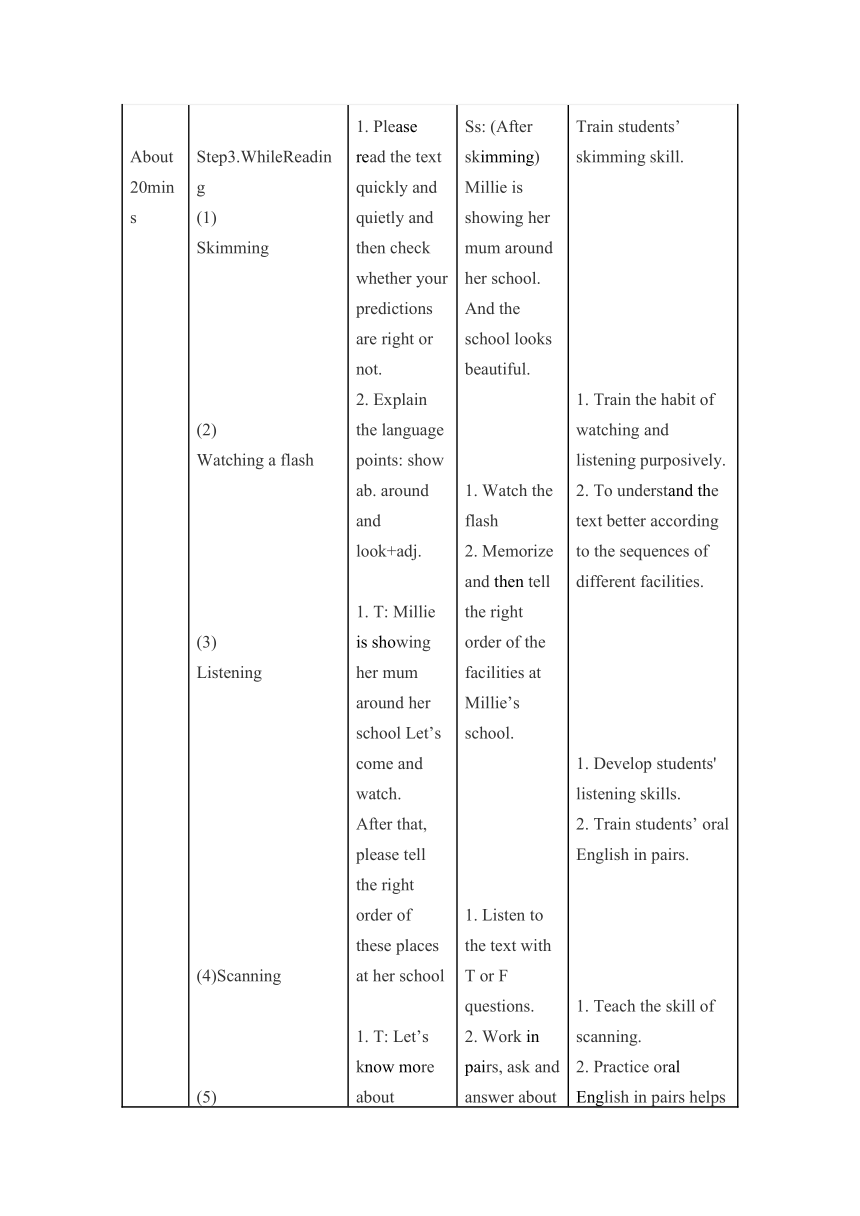译林牛津英语 7A Unit3 Welcome to our school—Reading I 教学设计
文档属性
| 名称 | 译林牛津英语 7A Unit3 Welcome to our school—Reading I 教学设计 |  | |
| 格式 | zip | ||
| 文件大小 | 17.5KB | ||
| 资源类型 | 教案 | ||
| 版本资源 | 牛津译林版 | ||
| 科目 | 英语 | ||
| 更新时间 | 2016-09-01 18:46:45 | ||
图片预览



文档简介
7A
Unit3
Welcome
to
our
school—Reading
I
教学设计
7A
Unit3
Welcome
to
our
school—Reading
IFocus
and
difficulties
of
the
lesson:1.
To
enable
students
to
introduce
different
places
at
school
and
show
others
around
a
school
in
a
real
circumstance.2.
To
help
students
understand
a
good
school
should
have
not
only
basic
hardware
facilities,
but
also
software
facilities,
which
means
hard-working
teachers
and
students.
Teaching
procedures
时间
教学环节
教师活动
学生活动
设计意图
About
5mins
Step1.
Warm
up &lead-in
1.
Greeting
and
free
talk.T:
What
a
beautiful
school
you
have!
Do
you
like
your
school 2.
T:
I
also
have
a
beautiful
school.
Let
me
introduce
my
school
to
you.
(
Play
a
clip
of
video
about
Walking
Around
Hua
Luogeng
Experimental
School.)3.Ask
students
to
tell
the
names
of
these
places
at
school.
1.
Listen
and
try
to
understand.2.
Tell
the
places
at
the
school
and
how
they
look.
1. Motivate
and
involve
students by
recalling
students'
prior
knowledge
about
school. 2.
To
present
and
teach
the
main
new
words
and
phrases
about
school
in
a
real
circumstance.
About1min
Step2.Pre-reading(prediction)
1. T:
Let’s
walk
around
Millie’s
school
today.
It’s
the
School
Open
Day
today
and
Millie
is
meeting
her
mum
at
the
school
gate.2. T: Can
you
guess
what
is
Millie
going
to
do
today
And
what
does
her
school
look
like
Predict
and
thenskim
the
text
with
two questions
about
the
text.
1.
Introduce
Millie’s
school
to
Ss.
Make
clear
of
the
topic
of
this
lesson:
Welcome
to
Millie’s
school. 2.
Guide
the
students
to
predict
before
reading.Prediction
can
help
students
think
actively
and
fully
engaged
in
class.
About20mins About11mins About6mins About2mins
Step3.WhileReading(1)Skimming (2)Watching
a
flash (3)Listening (4)Scanning (5)Discussion Step4:
After
reading(1)Complete
the
diary. (2)Retell Step5:
Group
work Step6.Discussion
1.
Please
read
the
text
quickly
and
quietly
and
then
check
whether
your
predictions
are
right
or
not.2.
Explain
the
language
points:
show
ab.
around
and
look+adj. 1.
T:
Millie
is
showing
her
mum
around
her
school
Let’s
come
and
watch.After
that,
please
tell
the
right
order
of
these
places
at
her
school 1.
T:
Let’s
know
more
about
different
places
at
Millie’s
school.
Listen
and
do
T
or
F
exercises.(Play
the
recorder)2:
T:
(summary)
They
are
basic
hardware
facilities
(基础硬件设施).
What
do
you
like
doing
at
these
places T:
What
are
these
places
like
at
Millie’s
school
Let’s
scan
the
text
and
get
some
detailed
information. 1.
Guide
the
students
toanswer
questions
about
theteacher
according
to
the text.2.
T:
If
he
is
your
teacher,
What
do
you
want
to
know
about
him
What
qualities
do
you
want
him
have
For
example,
what’s
he
like Work
in
pairs
and
discuss. T:
You
have
known
much
about
Millie’s
school
now.
Can
you
help
Millie
finish
the
diary
about
the
School
Open
Day Set
up
an
example
and
help
students
retell
the
text. 1.
Work
in
groups
of
four.2.Try
to
draw
a
map
about
some
places
at
your
school
(2-3places)3.
Introduce
your
school
to
others.(more
than
eight
sentences) 1.
Show
some
pictures
of
two
schools.2. Guide
the
students
to
think
about
the
question:
What
makes
a
good
school 3.
Encourage
students
to
cherish
and
work
harder.
Ss:
(After
skimming)
Millie
is
showing
her
mum
around
her
school.
And
the
school
looks
beautiful. 1.
Watch
the
flash2.
Memorize
and
then
tell
the
right
order
of
the
facilities
at
Millie’s
school. 1. 2. 1.
Listen
to
the
text
with
T
or
F
questions.2.
Work
in
pairs,
ask
and
answer
about
activities
at
different
places. Scan
the
text
for
detailed
information.Work
in
pairs
and
talk
about
the
places
with
the
right
answer. Talk
about
the
teachers,
answer
questions
according
to
the
text
first,
then
discuss
and
try
to
raise
any
questions
about
the
teacher
in
pairs
openly. Try
to
review
and
then
fill
in
the
blanks
of
the
letter. Retell
the
text
according
to
some
key
words
and
phrases. Work
in
groups
todraw
a
simple
map
and
then
talk
about
their
own
school
with
it. See
pictures
and
think
deeply
about
what
makes
a
good
school.
Train
students’
skimming
skill. 1.
Train
the
habit
of
watching
and
listening
purposively.2.
To
understand
the
text
better
according
to
the
sequences
of
different
facilities. 1.
Develop
students'
listening
skills.2.
Train
students’
oral
English
in
pairs. 1.
Teach
the
skill
of
scanning.2.
Practice
oral
English
in
pairs
helps
students
learn
more
effectively. 1.
Software
facilities
(teachers
and
students)
are
more
important
as
for
a
good
school.2.
These
open
questions
help
broaden
students’
thinking
model
and
boost
the
desire
of
speaking
English
freely. Help
students
get
a
better
understanding
of
the
text
and
consolidate
what
they
have
learned. Check
and evaluate
( javascript:void(0); ) students’
learning. 1.
Learning
by
doing.2.
Experience
joy,
confidence
and
pride
after
cooperative
learning
while
introducing
their
own
school
to
others.
Boost
students’
desire
to
communicate
in
English. Emotional
education:Help
students
develop
a
positive
attitude
towards
studying
at
school.
Make
students
cherish
school
life
and
educate
them
to
work
harder.
Homework
1. 1.
Read
the
text
more
after
class.2. 2.
Design
a
poster
about
your
own
school.
Unit3
Welcome
to
our
school—Reading
I
教学设计
7A
Unit3
Welcome
to
our
school—Reading
IFocus
and
difficulties
of
the
lesson:1.
To
enable
students
to
introduce
different
places
at
school
and
show
others
around
a
school
in
a
real
circumstance.2.
To
help
students
understand
a
good
school
should
have
not
only
basic
hardware
facilities,
but
also
software
facilities,
which
means
hard-working
teachers
and
students.
Teaching
procedures
时间
教学环节
教师活动
学生活动
设计意图
About
5mins
Step1.
Warm
up &lead-in
1.
Greeting
and
free
talk.T:
What
a
beautiful
school
you
have!
Do
you
like
your
school 2.
T:
I
also
have
a
beautiful
school.
Let
me
introduce
my
school
to
you.
(
Play
a
clip
of
video
about
Walking
Around
Hua
Luogeng
Experimental
School.)3.Ask
students
to
tell
the
names
of
these
places
at
school.
1.
Listen
and
try
to
understand.2.
Tell
the
places
at
the
school
and
how
they
look.
1. Motivate
and
involve
students by
recalling
students'
prior
knowledge
about
school. 2.
To
present
and
teach
the
main
new
words
and
phrases
about
school
in
a
real
circumstance.
About1min
Step2.Pre-reading(prediction)
1. T:
Let’s
walk
around
Millie’s
school
today.
It’s
the
School
Open
Day
today
and
Millie
is
meeting
her
mum
at
the
school
gate.2. T: Can
you
guess
what
is
Millie
going
to
do
today
And
what
does
her
school
look
like
Predict
and
thenskim
the
text
with
two questions
about
the
text.
1.
Introduce
Millie’s
school
to
Ss.
Make
clear
of
the
topic
of
this
lesson:
Welcome
to
Millie’s
school. 2.
Guide
the
students
to
predict
before
reading.Prediction
can
help
students
think
actively
and
fully
engaged
in
class.
About20mins About11mins About6mins About2mins
Step3.WhileReading(1)Skimming (2)Watching
a
flash (3)Listening (4)Scanning (5)Discussion Step4:
After
reading(1)Complete
the
diary. (2)Retell Step5:
Group
work Step6.Discussion
1.
Please
read
the
text
quickly
and
quietly
and
then
check
whether
your
predictions
are
right
or
not.2.
Explain
the
language
points:
show
ab.
around
and
look+adj. 1.
T:
Millie
is
showing
her
mum
around
her
school
Let’s
come
and
watch.After
that,
please
tell
the
right
order
of
these
places
at
her
school 1.
T:
Let’s
know
more
about
different
places
at
Millie’s
school.
Listen
and
do
T
or
F
exercises.(Play
the
recorder)2:
T:
(summary)
They
are
basic
hardware
facilities
(基础硬件设施).
What
do
you
like
doing
at
these
places T:
What
are
these
places
like
at
Millie’s
school
Let’s
scan
the
text
and
get
some
detailed
information. 1.
Guide
the
students
toanswer
questions
about
theteacher
according
to
the text.2.
T:
If
he
is
your
teacher,
What
do
you
want
to
know
about
him
What
qualities
do
you
want
him
have
For
example,
what’s
he
like Work
in
pairs
and
discuss. T:
You
have
known
much
about
Millie’s
school
now.
Can
you
help
Millie
finish
the
diary
about
the
School
Open
Day Set
up
an
example
and
help
students
retell
the
text. 1.
Work
in
groups
of
four.2.Try
to
draw
a
map
about
some
places
at
your
school
(2-3places)3.
Introduce
your
school
to
others.(more
than
eight
sentences) 1.
Show
some
pictures
of
two
schools.2. Guide
the
students
to
think
about
the
question:
What
makes
a
good
school 3.
Encourage
students
to
cherish
and
work
harder.
Ss:
(After
skimming)
Millie
is
showing
her
mum
around
her
school.
And
the
school
looks
beautiful. 1.
Watch
the
flash2.
Memorize
and
then
tell
the
right
order
of
the
facilities
at
Millie’s
school. 1. 2. 1.
Listen
to
the
text
with
T
or
F
questions.2.
Work
in
pairs,
ask
and
answer
about
activities
at
different
places. Scan
the
text
for
detailed
information.Work
in
pairs
and
talk
about
the
places
with
the
right
answer. Talk
about
the
teachers,
answer
questions
according
to
the
text
first,
then
discuss
and
try
to
raise
any
questions
about
the
teacher
in
pairs
openly. Try
to
review
and
then
fill
in
the
blanks
of
the
letter. Retell
the
text
according
to
some
key
words
and
phrases. Work
in
groups
todraw
a
simple
map
and
then
talk
about
their
own
school
with
it. See
pictures
and
think
deeply
about
what
makes
a
good
school.
Train
students’
skimming
skill. 1.
Train
the
habit
of
watching
and
listening
purposively.2.
To
understand
the
text
better
according
to
the
sequences
of
different
facilities. 1.
Develop
students'
listening
skills.2.
Train
students’
oral
English
in
pairs. 1.
Teach
the
skill
of
scanning.2.
Practice
oral
English
in
pairs
helps
students
learn
more
effectively. 1.
Software
facilities
(teachers
and
students)
are
more
important
as
for
a
good
school.2.
These
open
questions
help
broaden
students’
thinking
model
and
boost
the
desire
of
speaking
English
freely. Help
students
get
a
better
understanding
of
the
text
and
consolidate
what
they
have
learned. Check
and evaluate
( javascript:void(0); ) students’
learning. 1.
Learning
by
doing.2.
Experience
joy,
confidence
and
pride
after
cooperative
learning
while
introducing
their
own
school
to
others.
Boost
students’
desire
to
communicate
in
English. Emotional
education:Help
students
develop
a
positive
attitude
towards
studying
at
school.
Make
students
cherish
school
life
and
educate
them
to
work
harder.
Homework
1. 1.
Read
the
text
more
after
class.2. 2.
Design
a
poster
about
your
own
school.
同课章节目录
- 预备课程
- Lesson 1 Nice to meet you !
- Lesson 2 A happy family
- Lesson 3 A nice school
- Lesson 4 You look cool !
- Lesson 5 Wonderful things
- Lesson 6 Have nice food
- Lesson 7 Enjoy our days
- Lesson 8 Let's have fun !
- Unit 1 This is me
- Unit 2 Let's play sports
- Unit 3 Welcome to our school
- Unit 4 My day
- Unit 5 Let’s celebrate
- Unit 6 Food and lifestyle
- Unit 7 Shopping
- Unit 8 Fashion
